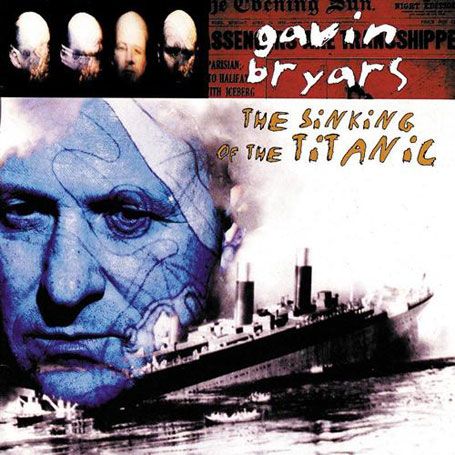 1. Gavin Bryars—The Sinking of the Titanic (1990)
1. Gavin Bryars—The Sinking of the Titanic (1990)
Take one of those faint radio transmissions that flits through the weak atmosphere of Callisto and follow it backward through space and time. The frost-scarred surface of that Jovian moon recedes rapidly as the radio wave pulls you back toward its point of origin. For a moment Jupiter itself occupies your field of vision but then fades away as you fly through the void, past rock and ice, deep into the asteroid belt. The protoplanet Ceres, king of the asteroids, approaches from one side, but yet you are still pulled back. Back past the red ball of Mars, dusty and ancient. Back to the green and blue of Earth, the gray sphere of the Moon but kissing distance away. Down past dead satellites, through the cool damp mists of the atmosphere. Down, down, down toward green hills and roads in some remote part of the world. Down into the steel of a massive antenna, into wires that run deep underground, protected. Down the wires, through soil and minerals, to room in a bunker deep inside a mountain.
In that room is one solitary woman calmly loading and transmitting data—the sum total of all human knowledge and endeavor—deep into space in the hope that somehow, someday some remote civilization might detect these transmissions and learn something from them, or least know that they aren't alone. Around her are cluttered desks and abandoned chairs, evidence of her many colleagues, all of whom, as the end approaches, have abandoned their posts and run off to be with their loved ones or to dash through the hills naked or to drink themselves into a stupor. Not her though. She has stayed at her post, remaining calm and carrying on, one final reassuring vestige of normalcy in the face of destruction, like the ship's band that continued playing on the deck as the Titanic sank.
That immortal image of the band playing to the very end is what this final album,
The Sinking of the Titanic by minimalist composer Gavin Bryars, is built around. His vision was of the band continuing on even as the ship slipped completely beneath the frigid waves of the North Atlantic, the notes of their songs echoing through the darkness of the water for the duration of their journey to the ocean floor. It has evolved significantly as a piece of music throughout its 40-plus years of existence, beginning life as a short open-ended piece written in 1969 and expanding both in scope and length in the following decades. It's been recorded multiple times: in 1975 for Brian Eno's Obscure Records label, in 1990 in a much longer form, and again in 2005 with avant-garde turntablist Philip Jeck.
It's the 1990 version that I'm discussing here. Robert Ballard's discovery of the long-missing wreck of the Titanic in 1986 had inspired in Bryars a desire to revisit and expand the piece and the result is really something to behold. Recorded live in the basement of an early nineteenth century Belgian water tower, the performance is an overwhelming experience of texture and mood. Mournful yet beautiful strings and horns fill the air with slow passages. Distant pinging and clanging echo around and around evoking twisting steel and dripping water deep in the bowels of the ship. Not quite discernible recordings of survivors' voices skip around in the shadows. And a boys' choir floats above it all like the spirits of the victims drifting up into the night sky.
This is not the kind of album you listen to casually, not something you throw on while you're cleaning the kitchen or going for a run. This is an album that's so emotional and so captivating that you just sit still and let it wash over you. From the clanging bell at the beginning to the fading notes at the end, it envelopes you in tragedy. The odd thing, though, about being so immersed in it, is that you begin to see other facets of those moments. The bravery and heroism. The sheer humanity. The cold beauty of waves and metal and stars.
For a moment the sky consuming mass of the Moon appears to just hang there, so close it seems that you could reach out and touch it. It looks different now in the reflected light of the Earth, no longer frozen and gray but warm and inviting. Those last few moments move with the pace of centuries as the world collectively closes its eyes and holds its breath. For a moment there is silence.
And then collision.
The ground buckles. Moondust rains down over the surface of the planet. The areas of the Earth's crust along the perimeter of the point of impact explode outward into space, trailing tails of magma in some synchronized cosmic ballet. The force of the event activates every volcano on the planet. Continents tear themselves to pieces. The seas boil. The atmosphere is ablaze. Every last flicker of life on Earth is extinguished. But rising out beyond the pandemonium at incredible speed are the last broadcasts of that lone woman in the chair. They race out across the solar system, carrying the final accounting of humanity—and of Earth—to places beyond. Past where we found them on Callisto, beyond the famous rings of Saturn and the less famous rings of Uranus, past the blue face of Neptune and the frozen wastes of Pluto, into the depths of space, toward some distant meeting with an unknown civilization, in an unknown time, in an unknown place.